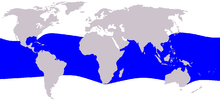‘SOCIABLE DOLPHINS’: MELON-HEADED WHALES
Last month, BMMRO undertook a joint expedition with FIELD SCHOOL to carry out research on sperm whales. This took them out into deep water, where another, quite different, cetacean species was also encountered on the final day – a huge pod of more than 100 melon-headed whales Peponocephala electra.
The melon-headed whale is in fact – like the FALSE KILLER WHALE I recently wrote about – a species of dolphin. It is sometimes more accurately called the melon-headed dolphin, which removes any confusion. These creatures are oceanic, preferring deeper waters. For that reason they are not often encountered, despite being quite common in tropical and sub-tropical waters around the world.
The MHW belongs to a dolphin species commonly known as blackfish. Other dolphins in this group included, for the Bahamas, the pygmy killer whale and the more frequently encountered pilot whale, a species than can be seen in the Sea of Abaco.
In some of these photos you can see the distinctive white lips of the MHW 
- The MHW’s head is rounded, lacking the obvious beak of more familiar dolphins
- The darker grey face is sometimes called a ‘mask’
- Their distinctive white lips are a good identifying feature
- They are capable of swimming at very fast speeds
- Like other dolphins, they make series of low jumps out of the water as they swim
- Their groups often contain 100 individuals, up to as many as 1000
- An adult grows to around 3m / 10′ long
- They live for at least 20 years, and females may live as long as 30 years
- As with many certaceans, their favourite food is squid
- Oh, did I mention that they are really dolphins and not whales at all?






















You must be logged in to post a comment.